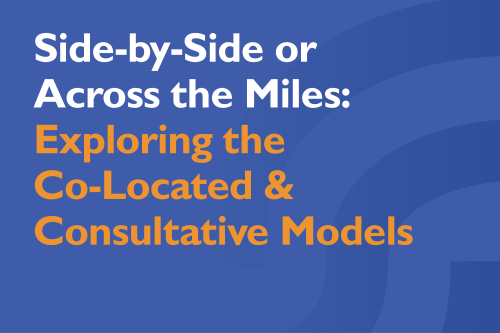Side-by-Side or Across the Miles: Exploring 2 Behavioral Health Integration Models

Behavioral health integration has become a cornerstone of modern healthcare delivery, bridging the gap between mental and physical health services. Among the various approaches to behavioral health integration, the Consultative Model and the Co-Located Model stand out as two widely implemented frameworks. While both seek to enhance patient care through behavioral health integration, they differ notably in their structural design, level of provider coordination, and impact on the patient experience.
The Consultative Model: A Partnership Across Distance
The Consultative Model of behavioral health integration focuses on collaboration between primary care providers and behavioral health specialists who generally operate from separate locations. In this approach, primary care providers identify patients with behavioral health concerns and seek input from external specialists as needed. Communication typically occurs through phone consultations, written correspondence, or electronic exchanges.
Key Features:
- Physical separation of providers.
- Periodic communication (rather than continuous collaboration).
- Referral-based approach, with the PCP remaining the primary coordinator of care.
- Focuses heavily on providing advice, treatment recommendations, or second opinions.
Benefits:
- Flexibility: Primary care providers can access specialized expertise without needing to house behavioral health professionals on-site.
- Resource-efficient: Ideal for smaller or rural practices where comprehensive behavioral health integration isn’t feasible.
Challenges:
- Limited collaboration: Because providers work separately, communication may be delayed or incomplete.
- Fragmented care: Patients may experience gaps between primary care and mental health services, leading to lower follow-through rates.
The Co-Located Model: Sharing Space, Enhancing Access
In contrast, the Co-Located Model integrates behavioral health providers within the same physical setting as primary care teams, typically in a shared clinic or medical office. Although behavioral health and primary care professionals may maintain distinct roles and clinical responsibilities, their close physical proximity facilitates streamlined referrals, real-time consultations, and more efficient communication. This arrangement enables providers to collaborate more readily and enhances the overall coordination of care. Effective behavioral health integration through co-location means patients benefit from improved access to behavioral health services, often receiving support during the same visit or shortly thereafter, which reduces barriers to care and supports a more holistic approach to health and wellness.
Key Features:
- Shared location, though clinical and billing systems may remain separate.
- Improved warm handoffs: Primary care providers can directly introduce patients to behavioral health providers during the same visit.
- Flexible consultation: Easier face-to-face provider discussions.
Benefits:
- Convenience for patients: Behavioral health services feel like a natural extension of primary care, reducing stigma and logistical barriers.
- Faster response times: On-site consultations and interventions can occur the same day.
- Enhanced communication: Physical proximity encourages more spontaneous collaboration.
Challenges:
- Operational complexity: Co-location requires careful planning around space, scheduling, and workflows.
- Partial integration: Without unified treatment plans or shared health records, care can still feel fragmented.
Which of These Behavioral Health Integration Models is Right for Your Organization?
Choosing between the Consultative and Co-Located Models of behavioral health integration requires careful consideration of several critical factors, including organizational infrastructure, the specific needs of the population served, availability of clinical and financial resources, and geographic constraints such as rural versus urban practice settings. Each model offers unique advantages that align differently with these variables.
The Consultative Model may be particularly well-suited for organizations with limited behavioral health staffing, or those serving rural or underserved areas where specialty providers are not readily accessible. Its flexibility allows primary care teams to tap into specialized expertise without requiring significant investment in new infrastructure or staffing. However, this model may pose challenges in terms of continuity of care and timely communication between providers.
On the other hand, the Co-Located Model offers the benefit of direct, face-to-face collaboration between behavioral health and primary care providers, enabling more immediate interventions, seamless referrals, and increased patient engagement. This approach can reduce stigma and improve follow-through, especially for individuals who may be reluctant to seek behavioral health care through traditional referral pathways. However, implementing a co-located model often requires significant upfront investment in space, staffing, and workflow redesign.
Ultimately, both of these behavioral health integration models represent essential strategies in advancing toward truly integrated, whole-person healthcare. As healthcare systems evolve and innovate, the shared objective remains to deliver care that is not only accessible and coordinated but also responsive to the physical, emotional, and behavioral health needs of every individual. Achieving this vision demands thoughtful integration tailored to the unique context of each care setting.
Author: Anthony Motsinger, PhD, LCSW

